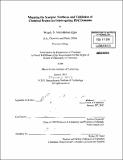| dc.contributor.advisor | Barbara Imperiali. | en_US |
| dc.contributor.author | Iskenderian-Epps, Wendy S | en_US |
| dc.contributor.other | Massachusetts Institute of Technology. Dept. of Chemistry. | en_US |
| dc.date.accessioned | 2011-05-09T15:25:48Z | |
| dc.date.available | 2011-05-09T15:25:48Z | |
| dc.date.copyright | 2011 | en_US |
| dc.date.issued | 2011 | en_US |
| dc.identifier.uri | http://hdl.handle.net/1721.1/62724 | |
| dc.description | Thesis (Ph. D.)--Massachusetts Institute of Technology, Dept. of Chemistry, 2011. | en_US |
| dc.description | Page 150 blank. Cataloged from PDF version of thesis. | en_US |
| dc.description | Includes bibliographical references. | en_US |
| dc.description.abstract | Macromolecular protein complexes at neuronal synapses are critical for establishing synaptic plasticity, which is the basis of information storage in the brain. These complexes consist of many PDZ domain-containing proteins. PDZ domains bind selectively to peptide sequences at the C-termini of partner proteins, and they play an essential role in the regulation of synaptic macromolecular complexes. While many PDZ domain-containing proteins are well characterized, much remains to be learned about their binding dynamics. The goal of the research presented herein is to gain a quantitative understanding of the complex PDZ-domain binding dynamics through the design, synthesis, and application of sensitive and selective biophysical probes. The peptidyl probes are based on three critical elements: solvatochromic fluorophores, molecular caging, and multivalency. This thesis presents the development of a systematic approach to screen for selective solvatochromic fluorophore-based probes for class I PDZ domains, and the biophysical characterization of probes for the PSD-95 and Shank3 PDZ domains. These probes have been utilized to examine the effects of Shank3 PDZ domain dimerization on ligand binding in vitro, and the quantitative results presented here implicate PDZ domain dimerization as a potential modular control mechanism for ligand-binding in the biological context. Further development of the probes via the application of a novel C-terminal caging strategy is also discussed. Validation in vitro shows the utility of a C-terminal 1-(2-nitrophenyl)ethyl cage for blocking the interaction between probe and cognate PDZ domain, and demonstrates the release of viable probe upon photoactivation of the molecular cage. This thesis also presents the in vivo application of PDZ domain probes, using the simple yet powerful eukaryotic C. elegans model system. Progress toward solvatochromic fluorophore-based probes for C. elegans Lin-10 PDZ domains is presented. Additionally, the design and synthesis of a bivalent peptidyl inhibitor, based on the C. elegans C-terminal sequence of STG-2 (a protein of the GLR-1 receptor complex), is discussed. This STG-2 sequence is a putative PDZ domain ligand, and its ortholog in higher eukaryotes functions in receptor-mediated multivalent interactions with partner PDZ domains. Electrophysiological data presented in this thesis suggest the effectiveness of the bivalent STG-2 peptide in the inhibition of the critical C. elegans GLR- 1 neural receptor complex. | en_US |
| dc.description.statementofresponsibility | by Wendy S. Iskenderian-Epps. | en_US |
| dc.format.extent | 150 p. | en_US |
| dc.language.iso | eng | en_US |
| dc.publisher | Massachusetts Institute of Technology | en_US |
| dc.rights | M.I.T. theses are protected by
copyright. They may be viewed from this source for any purpose, but
reproduction or distribution in any format is prohibited without written
permission. See provided URL for inquiries about permission. | en_US |
| dc.rights.uri | http://dspace.mit.edu/handle/1721.1/7582 | en_US |
| dc.subject | Chemistry. | en_US |
| dc.title | Mapping the synapse : synthesis and validation of chemical probes for interrogating PDZ domains | en_US |
| dc.title.alternative | Synthesis and validation of chemical probes for interrogating PDZ domains | en_US |
| dc.type | Thesis | en_US |
| dc.description.degree | Ph.D. | en_US |
| dc.contributor.department | Massachusetts Institute of Technology. Department of Chemistry | |
| dc.identifier.oclc | 716238108 | en_US |
